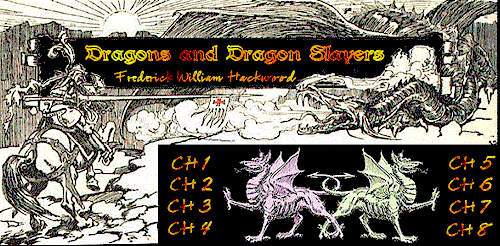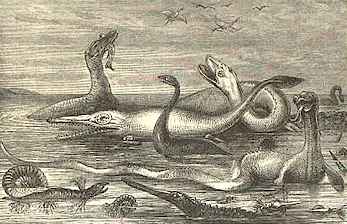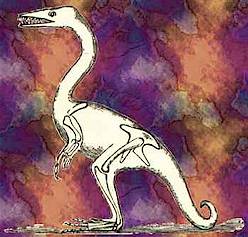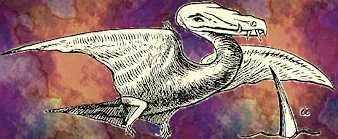
![]()
CHAPTER EIGHT
~ The Real
Dragons of Nature ~
![]()
|
LONG, long before the earth was fitted for man to live upon, there was an Age of Reptiles, when crawling scaly monsters, some of them of enormous size, lurked in the immense swampy forests with which a vast portion of the surface of the earth was then covered, while innumerable dragon-flies swept and flashed through the air. Man had not yet appeared on the earth, and it is difficult to imagine the strange appearance the world presented when these nondescript monsters occupied the earth and sea and sky with undisputed sway. These strange and formidable-looking beasts have one and all disappeared ages ago, and are now extinct - indeed, the disappearance and extinction of animals is a process we know to be still going on in the history of the earth. Of the existence of these gigantic monsters which once inhabited the earth, abundant evidence is to be seen in the larger geological museums of the world which are capable of finding room for their fossil remains. They were the dominant animals of the earth millions of years ago, when numerous species were evolved, some adapting themselves as land animals, others being able to live on the land or in the water, and others again being able to rise into the air like birds.
progressed on land in a creeping manner, their cartilage-capped joints being apparently incapable of supporting and properly balancing their bodies. A visit to the Natural History Museum at Kensington, where many of their fossil remains are mounted, will give a better idea of their size, shape, and structure than can be conveyed by any verbal description possible. The bones of these long-departed creatures, having been buried and lain in the earth for countless ages, have themselves turned to stone, or as we say, have become fossilised. But geologists and other learned men who have dug them out can not only put these fossil parts together correctly and reconstruct the entire skeleton, but from their scientific knowledge can tell us their actual appearance, the kind of food they ate, and in fact all about their habits of life. They were unlike any reptile now living. Their immensely thick hides were rough and tough, with an excess of wartiness ; they are known as Saurians, because they belonged to the scaly reptiles of the lizard-kind. A reconstruction of their frames show that they were huge and frightfully hideous creatures, whose terrible aspect would certainly not be lessened by their methods of approach - an ungainly, rolling crawl ; or in the case of water-dwelling monsters such as the Plesiosaurus, with the flashings of awkward paddling flappers. The sea-lizards of that far-away time were numerous and varied in form. The Icthyosaurus was a shark-like reptile. The Plesiosaurus had a tremendously long neck which carried a small and easily supported head ; if, in swimming, it held its head and immense snake-like neck out of the water, it must have given an impression of what the sea-serpent is said to assume in all sailor's yarns. Then there was the vast Cetiosaurus, so called because of its whale-like proportions, though it little resembled a whale in aught else.
their powerful-looking tails suggest that they were good swimmers, and their teeth that they fed on fish. Other Dinosaurs, having a different environment, were vegetable feeders. Some were horned, and all were armoured with a thick hide that was in places double-folded. Some were scaly, some warty, and some protected with fearfully notchy spines. The Stegosaurus was a huge torpid reptile of queer shape standing 20 feet high. Another armoured Dinosaur had powerful hind-legs on which it stood up very much as a kangaroo does. The Brontosaurus was a gigantic Dinosaur measuring nearly 60 feet in length ; while the Atlantosaurus stretched nearly 80 feet, and if it walked on its hind-feet stood up 30 feet high. The rhinoceros-like Triceratops, or three-horned Stegosaur, was a plated lizard that stood 15 feet high, herbivorous in habit. Specimens have been found in the chalk deposits of Wyoming in America, and another species in the lias at Charmouth in this country, which shows how widely distributed over the earth these creatures were. As this creature had some resemblance to the rhinoceros, so had the Dinotherium to the elephant type. Probably no other living creature ever reached more enormous proportions that the Diplodocus, a geologic reptile which from the end of the snout to the tip of the tail measured over 80 feet. This monster was a vegetable feeder ; had it devoured animal food, a whole colony of breeding animals would have been needed to keep it alive. As it lived chiefly on the leaves and twigs of trees, it must have stripped a fair-sized tree of its foliage at every meal. The Diplodocus probably lived much in shallow water, in which case it also browsed largely on sea-weed ; it could walk in water 30 to 40 feet deep to feed and raise its head comfortably above the surface for breathing and chewing. Were such a creature alive now, it could easily look over the tops of our houses while walking along the street. The flying reptiles belonged to the great middle period of geological history. It is just possible that all fables and myths of dragons may have originated in the finding of the petrified limb-bones of an antediluvian monster in some ancient cave. But it is curious to observe that wings are always associated with the forelimbs of the typical dragon. Even those fabled monsters of Oriental antiquity, the Chinese dragon and the Japanese dragon, belong to the common stock. The idea of a flying animal, or rather of the larger pedestrian animals being endowed with the added power of flight, has in many ages exercised the human imagination and excited man's freest inventive fancies ; whence we have derived our artistic conceptions of flying horses, of winged bulls and winged lions, even of conventional angels and cherubim, and other mystic messengers between earth and heaven. The Pteranodon was a great finger-winged reptile of the Chalk Age whose leathery, featherless wings, measuring 18 feet from tip to tip, must have made high heaven hideous to behold. Its wing-fingers were real bone and supported the membrane worked by muscles in the crest at the back of the head ; the jaws were toothless and formed a beak ; the general structure of the animal seeming to indicate that it fed on fish. There were many varieties of these flying-dragons, some large and some small, some short-tailed and others with long tails. Imagine a gigantic frog with the wings of an enormous bat and a monstrous beak, and some faint conception may be formed of the actual living creatures from which the idea of the fabled dragon has in all probability been derived.
Of these weird prehistoric monsters the range in hideous and grotesque ugliness, if not in the terrifying hugeness of their size, is by no means exhausted in the few named here. It is undoubtedly in these twos attributes of unutterable hideousness and ferocious enormity that they have for ages been at the back of men's minds in the shaping of the conventional dragon of myth and legend. Thus the poet Tennyson speaks of the - "Dragons
of the prime, Yet no good evidence could be produced to prove the memory of tradition connecting the fabled and imaginary dragon with the real and actual animals of Geologic periods. The hypothesis, however, is one which has received support from the imaginative and artistic. And it is really curious to notice that in some of the inventions of the Middle Ages, the grotesque creatures carved or painted as dragons reproduced with strange faithfulness some of the features of these extinct creatures which had disappeared from the face of the earth ages before man appeared upon it. It is very evident that in olden times the people felt there was some tangible connection between the fabled dragon and the living creatures of the earth. In churches at Marseilles, Lyons, Ragusa, and Cimiers, skins of stuffed crocodiles are exhibited as the remains of dragons. There is exhibited in one Continental church an excellent old painting of St. George and the Dragon in which the dragon is evidently an Iguanodon, a colossal fossilised lizard, extinct ages before history began. At Rhodes was long preserved what purported to be the head of a terrible dragon killed by Diuedonné, of Gozo a knight of Rhodes, and afterwards Grand Master of the Order, in the fourteenth century. When the knights were driven out of Rhodes by the Turks, they, respecting bravery even in a Christian, preserved the relic with equal care ; it was seen by the French traveller Thevenot as late as the middle of the seventeenth century, and from his account there can be no doubt that it was the head of a hippopotomus. Again, at Klagenfurt, in Carinthia, is a public fountain on the stone-work of which is carved a huge dragon with six feet and a monstrous head surmounted by a stout horn. Local legend has it that this dragon lived in a cave near by, from which it periodically sallied forth to devour the people and ravage the country. At length was forthcoming a knightly champion to essay the town's deliverance ; he sought out the evil beast, attacked, and fought it to the death, but not without paying the forfeit of his own life. In the adjacent Hôtel de Ville is preserved the preserved the pretended head of the vanquished dragon, a relic which furnished the model for the sculptor of the well ; but, alas ! modern science has identified the precious memento as the cranium of a fossil rhinoceros ! Here, then, we have acquainted ourselves with the views and speculations of those who have been inclined to adopt a naturalistic solution to the problem of deriving the many and persistent dragon superstitions from the existence of the huge and Saurian reptiles of the dim Geologic Ages. But the theory fails on further reflection to satisfy the mind, when we take into consideration the nature of geologic time. The immense lizards of the Oolitic period had become extinct countless ages before man appeared on the earth, and even the huge Dinotherium found in the Upper Miocene formation. The survival of any oral tradition concerning the primaeval monsters was impossible. As to the creatures themselves, it is doubtful whether the huge reptilian denizens of the steaming earth could possibly have existed under the natural conditions which prevailed at a later period of the world's history. |



